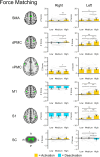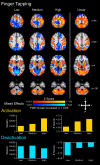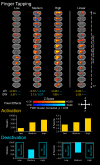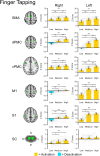Mapping hand function with simultaneous brain-spinal cord functional MRI
- PMID: 41064375
- PMCID: PMC12501243
- DOI: 10.1162/IMAG.a.159
Mapping hand function with simultaneous brain-spinal cord functional MRI
Abstract
Hand motor control depends on intricate brain-spinal cord interactions that regulate muscle activity. Hand function can be disrupted by injury to the brain, spinal cord, and peripheral nerves leading to weakness and impaired coordination. Functional MRI (fMRI) can map motor-related neural activity and potentially characterize the mechanisms underlying hand weakness and diminished coordination. Although brain motor control has been extensively studied, spinal cord mechanisms remain less explored. Here we use simultaneous brain-spinal cord fMRI to map neural activity related to hand strength and dexterity across the central nervous system using force matching and finger tapping tasks. We performed simultaneous brain-spinal cord fMRI in 28 right-handed healthy volunteers (age: 40.0 ± 13.8 years, 14 females, 14 males) using a 3T GE scanner. Participants performed a force-matching task at 10%, 20%, and 30% of maximum voluntary contraction. For the finger tapping task, participants completed button presses for three task levels: single-digit response with the second digit only, single-digit response with all digits in a sequential order, and single-digit response with all digits in a random order. Brain and spinal cord images were processed separately and assessed both activations and deactivations. Region of interest (ROI) analyses were also conducted to explore localized changes in activation across the task levels. Both tasks elicited activation in motor and sensory regions of the brain and spinal cord, with graded responses in the left primary motor (M1), left primary sensory (S1) cortex, and right spinal cord gray matter across task levels. Deactivation of the right M1 and S1 was also present for both tasks. Deactivation of the left spinal cord gray matter that scaled with task level was seen in the force matching task. The ROI analysis findings complemented the group level activity maps. Our study provides a detailed map of brain-spinal cord interactions in hand function, revealing graded neural activation and deactivation patterns across motor and sensory regions. Right M1 deactivation is likely evidence of interhemispheric inhibition that restricts extraneous motor output during unilateral tasks. For force matching, the deactivation of the left ventral and dorsal horns of the spinal cord provides the first evidence that the inhibition of motor areas during a unilateral motor task extends to the spinal cord. Whether this inhibition results from direct descending modulation from the brain or interneuronal inhibition in the spinal cord remains to be interrogated. These findings expand our understanding of central motor control mechanisms and could inform rehabilitation strategies for individuals with motor impairments. This approach may offer a foundation for studying motor dysfunction in conditions such as stroke, spinal cord injury, and neurodegenerative diseases.
Keywords: brain; functional MRI; hand strength; motor activity; musculoskeletal and neural physiological phenomena; spinal cord.
© 2025 The Authors. Published under a Creative Commons Attribution 4.0 International (CC BY 4.0) license.
Conflict of interest statement
The authors declare no competing interests.
Figures







Update of
-
Mapping Hand Function with Simultaneous Brain-Spinal Cord Functional MRI.bioRxiv [Preprint]. 2025 Feb 27:2025.02.27.640504. doi: 10.1101/2025.02.27.640504. bioRxiv. 2025. Update in: Imaging Neurosci (Camb). 2025 Oct 03;3:IMAG.a.159. doi: 10.1162/IMAG.a.159. PMID: 40060434 Free PMC article. Updated. Preprint.
References
-
- Andersson, J. L. R., Jenkinson, M., & Smith, S. (2007). Non-linear registration aka Spatial normalisation FMRIB Technial Report TR07JA2. Retrieved July 26, 2024, from https://www.fmrib.ox.ac.uk/datasets/techrep/tr07ja2/tr07ja2.pdf
LinkOut - more resources
Full Text Sources
